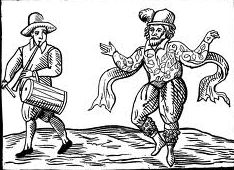 The Fool’s Jig [Jockie to the Fair]
The Fool’s Jig [Jockie to the Fair]
Played by Kenworthy Schofield on Pipe and Tabor
From the EFDSS EP: RPL 1113 [P.R.303] (n.d. 1958?)
Note: The Fool’s Jig, here, incorporates the Bacca Pipes (1st, 2nd, 3rd & 4th figures)
The purpose of the Fools Jig is to enable the fool, who is usually a very clever dancer, to show his prowess. To this end, the Foot-up and the Jig should be danced at the highest possible speed, compatible with a proper and neat execution of all the steps and movements.
No handkerchiefs are used, but the fool holds in one or other of his hands a stick about five inches in length and one and a-half inches in diameter. In the Foot-up and Capers the stick is held in the right hand.
(Sharp & Macilwaine 1910, p. 76)
The Fool’s Jig is being played here by Dr. Kenworthy Schofield on the pipe and tabor. Dr. Robert Kenworthy Schofield (1901-1960) first became involved in English folk music and folk dance during the Peace Day celebrations of 1918, at the end of the First World War (1914-1918). At Cambridge University he joined the local branch of the English Folk Dance Society (EFDS) and became a founder member of “The Travelling Morrice”. It was on Morris tours in the Cotswold that he met some of the surviving traditional dancers and musicians. His notes about these encounters can be found in the EFDS Journals for 1928, 1930 and 1934. Later he was one of those responsible for the formation of “The Morris Ring”. Outside his music Dr. Schofield was a physicist who, after leaving Cambridge, worked at the Rothamsted Research Station in St. Albans. He was the author of a number of scientific papers.
♣ ♣ ♣ ♣
Dr. Robert Kenworthy Schofield (1901-1960) first became involved in English folk music and folk dance during the Peace Day celebrations of 1918, at the end of the First World War (1914-1918). At Cambridge University he joined the local branch of the English Folk Dance Society (EFDS) and became a founder member of “The Travelling Morrice”. It was on Morris tours in the Cotswold that he met some of the surviving traditional dancers and musicians. His notes about these encounters can be found in the EFDS Journals for 1928, 1930 and 1934. Later he was one of those responsible for the formation of “The Morris Ring”. Outside his music Dr. Schofield was a physicist who, after leaving Cambridge, worked at the Rothamsted Research Station in St. Albans. He was the author of a number of scientific papers.
